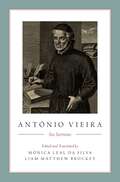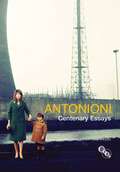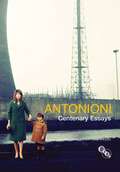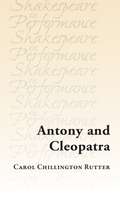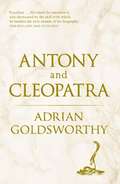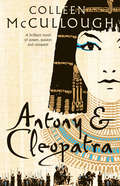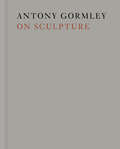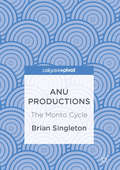- Table View
- List View
The Antonines: The Roman Empire in Transition
by Michael GrantThe Antonines - Antoninus Pius, Marcus Aurelius, Lucius Verus and Commodus - played a crucial part in the development of the Roman empire, controlling its huge machine for half a century of its most testing period. Edward Gibbon observed that the epoch of the Antonines, the 2nd century A.D., was the happiest period the world had ever known.In this lucid, authoritative survey, Michael Grant re-examines Gibbon's statement, and gives his own magisterial account of how the lives of the emperors and the art, literature, architecture and overall social condition under the Antonines represented an `age of transition'. The Antonines is essential reading for anyone who is interested in ancient history, as well as for all students and teachers of the subject.
Antonio de Viti de Marco: A Story Worth Remembering
by Manuela MoscaThis book provides insight into the remarkable life and work of the Italian economist Antonio de Viti de Marco (1858-1943). This book presents eleven interviews with American and Italian scholars from various disciplines that provide a profile of this major intellectual as an economic theorist, politician, and individual. He was the founder of the pure theory of Public Finance, played an important role in the foundation of Public Choice, and was also a staunch liberal and radical politician. An English translation of one of his books, made as early as 1936, greatly influenced James M. Buchanan, Nobel prize-winner for economics.
Antonio Gramsci: An Intellectual Biography (Marx, Engels, and Marxisms)
by Gianni FresuThis intellectual biography provides an organic framework for understanding Antonio Gramsci’s process of intellectual development, paying close attention to the historical and intellectual contexts out of which his views emerged. The Gramsci in Notebooks cannot fully account for the young director of L’Ordine Nuovo, or for the communist leader. Gramsci’s development did not occur under conditions of intellectual inflexibility, of absence of evolution. However, there is a strong thread connecting the “political Gramsci” with Gramsci as a “cultivated man.” The Sardinian intellectual’s life is marked by the drama of World War I, the first mass conflict in which the great scientific discoveries of the previous decades were applied on a large scale and in which millions of peasants and workers were slaughtered. In all of his theoretical formulations, this dual relation, which epitomizes the instrumental use of “simpletons” by ruling classes, goes beyond the military context of the trenches and becomes full-fledged in the fundamental relations of modern capitalist society. In contrast with this notion of social hierarchy, which is deemed natural and unchangeable, Gramsci constantly affirmed the need to overcome the historically determined rupture between intellectual and manual functions, due to which the existence of a priesthood or of a separate caste of specialists in politics and in knowledge is made necessary. It is not the specific professional activity (whether material or immaterial) that determines the essence of human nature: to Gramsci, “all men are philosophers.” In this passage from Notebooks, we find the condensed form of his idea of “human emancipation,” which is the historical need for an “intellectual and moral reform”: the subversion of traditional relations between rulers and ruled and the end of exploitation of man by man.
Antonio Gramsci (Critical Explorations in Contemporary Political Thought)
by Mark McNallyThe thought of Antonio Gramsci continues to enjoy widespread appeal in contemporary political and social theory. This book draws together some of the world's leading scholars on Gramsci to critically explore key ideas, debates and themes in his work in an accessible manner, relating them to contemporary politics and society.
Antonio Gramsci and the Ancient World (Routledge Monographs in Classical Studies)
by Emilio Zucchetti Anna Maria CiminoAntonio Gramsci and the Ancient World explores the relationship between the work of the Italian Marxist thinker Antonio Gramsci and the study of classical antiquity. The collection of essays engages with Greek and Roman history, literature, society, and culture, offering a range of perspectives and approaches building on Gramsci’s theoretical insights, especially from his Prison Notebooks. The volume investigates both Gramsci’s understanding and reception of the ancient world, including his use of ancient sources and modern historiography, and the viability of applying some of his key theoretical insights to the study of Greek and Roman history and literature. The chapters deal with the ideas of hegemony, passive revolution, Caesarism, and the role of intellectuals in society, offering a complex and diverse exploration of this intersection. With its fascinating mixture of topics, this volume will be of great interest to students and scholars of classics, ancient history, classical reception studies, Marxism and history, and those studying Antonio Gramsci’s works in particular.
Antonio Gramsci and the Ancient World (Routledge Monographs in Classical Studies)
by Emilio Zucchetti Anna Maria CiminoAntonio Gramsci and the Ancient World explores the relationship between the work of the Italian Marxist thinker Antonio Gramsci and the study of classical antiquity. The collection of essays engages with Greek and Roman history, literature, society, and culture, offering a range of perspectives and approaches building on Gramsci’s theoretical insights, especially from his Prison Notebooks. The volume investigates both Gramsci’s understanding and reception of the ancient world, including his use of ancient sources and modern historiography, and the viability of applying some of his key theoretical insights to the study of Greek and Roman history and literature. The chapters deal with the ideas of hegemony, passive revolution, Caesarism, and the role of intellectuals in society, offering a complex and diverse exploration of this intersection. With its fascinating mixture of topics, this volume will be of great interest to students and scholars of classics, ancient history, classical reception studies, Marxism and history, and those studying Antonio Gramsci’s works in particular.
Antonio Serra and the Economics of Good Government (Palgrave Studies in the History of Finance)
by Rosario Patalano Sophus ReinertIn this book some of the world's leading economists and experts on Serra explore the enduring appeal of his 1613 Breve trattato.
António Vieira: Six Sermons
by Mónica Leal Silva Liam BrockeyThis volume is the first English translation and annotation of the sermons of António Vieira, a major cultural figure in the Portuguese-speaking world. Born in Lisbon in 1608, Vieira was a Jesuit who lived and worked in both Europe and Brazil in the service of the church and the Portuguese crown. His sermons are among the most renowned pieces of baroque oratory in the Portuguese language. These carefully selected sermons offer insight into Vieira's visionary thought on social and spiritual matters. In the Sermon for the Success of Portuguese Arms against the Dutch, Vieira inveighs against God for His apparent abandonment of the Portuguese and begs for divine intervention. His Sermon of St. Anthony is an allegory that addresses the inequities that he witnessed in Brazil. The Sexagesima Sermon parodies literary clichés from his time while prescribing a more effective, if harsher, style of preaching. The Sermon of the Good Thief is a rebuke to the imperial officials who used their positions for personal enrichment, and a warning to kings against complicity with corruption. Vieira's Sermon XXVII addresses African slaves and their Brazilian masters, attempting to comfort the first group in their trials and to admonish the second for their brutality. Finally, the Sermon called Arm tells the story of the relic of Francis Xavier's arm sent from India to Italy in 1614, and pays tribute to the obedience of Vieira's Jesuit predecessor.
António Vieira: Six Sermons
by Mónica Leal Silva Liam BrockeyThis volume is the first English translation and annotation of the sermons of António Vieira, a major cultural figure in the Portuguese-speaking world. Born in Lisbon in 1608, Vieira was a Jesuit who lived and worked in both Europe and Brazil in the service of the church and the Portuguese crown. His sermons are among the most renowned pieces of baroque oratory in the Portuguese language. These carefully selected sermons offer insight into Vieira's visionary thought on social and spiritual matters. In the Sermon for the Success of Portuguese Arms against the Dutch, Vieira inveighs against God for His apparent abandonment of the Portuguese and begs for divine intervention. His Sermon of St. Anthony is an allegory that addresses the inequities that he witnessed in Brazil. The Sexagesima Sermon parodies literary clichés from his time while prescribing a more effective, if harsher, style of preaching. The Sermon of the Good Thief is a rebuke to the imperial officials who used their positions for personal enrichment, and a warning to kings against complicity with corruption. Vieira's Sermon XXVII addresses African slaves and their Brazilian masters, attempting to comfort the first group in their trials and to admonish the second for their brutality. Finally, the Sermon called Arm tells the story of the relic of Francis Xavier's arm sent from India to Italy in 1614, and pays tribute to the obedience of Vieira's Jesuit predecessor.
Antonioni: Centenary Essays
by Laura Rascaroli John David RhodesThis collection of new essays by leading film scholarsaddresses Michelangelo Antonionias apre-eminent figure in European art cinema, explores his continuing influence and legacy, and engages with his ability to both interpret and shape ideas of modernity and modern cinema.
Antonioni: Centenary Essays
This collection of new essays by leading film scholarsaddresses Michelangelo Antonionias apre-eminent figure in European art cinema, explores his continuing influence and legacy, and engages with his ability to both interpret and shape ideas of modernity and modern cinema.
Antony and Cleopatra (Shakespeare in Performance)
by Carol Chillington RutterThis book writes a performance history of Antony and Cleopatra, Shakespeare’s most ambiguous play, from 1606 to the present. It observes the choices that actors, directors, designers, musicians and adapters have made each time they have brought the play’s thoughts on power, race, masculinity, regime change, exoticism, love, dotage and delinquency into alignment with a new present. Informed by close attention to theatre records – promptbooks, stage managers’ reports, reviews – it offers in-depth analyses of fifteen international productions by (among others) the Royal Shakespeare Company, Citizens Theatre Glasgow, Northern Broadsides, Berliner Ensemble and Toneelgroep Amsterdam. It ends seeing Shakespeare’s black Egyptian Queen Cleopatra – whited-out in performance for centuries – restored to the contemporary stage. Written in a lively and accessible style, this book will be of interest to students, academics, actors, directors and general readers alike.
Antony and Cleopatra (Shakespeare in Performance)
by Carol Chillington RutterThis book writes a performance history of Antony and Cleopatra, Shakespeare’s most ambiguous play, from 1606 to the present. It observes the choices that actors, directors, designers, musicians and adapters have made each time they have brought the play’s thoughts on power, race, masculinity, regime change, exoticism, love, dotage and delinquency into alignment with a new present. Informed by close attention to theatre records – promptbooks, stage managers’ reports, reviews – it offers in-depth analyses of fifteen international productions by (among others) the Royal Shakespeare Company, Citizens Theatre Glasgow, Northern Broadsides, Berliner Ensemble and Toneelgroep Amsterdam. It ends seeing Shakespeare’s black Egyptian Queen Cleopatra – whited-out in performance for centuries – restored to the contemporary stage. Written in a lively and accessible style, this book will be of interest to students, academics, actors, directors and general readers alike.
Antony and Cleopatra
by Adrian GoldsworthyThe epic story of one of the most famous love affairs in history, by the bestselling author of Caesar.*****The monumental love affair between Antony and Cleopatra has been depicted in countless novels, plays and films. As one of the three men in control of the Roman Empire, Antony was perhaps the most powerful man of his day. And Cleopatra, who had already been Julius Caesar's lover, was the beautiful queen of Egypt, Rome's most important province. The clash of cultures, the power politics, and the personal passion have proven irresistible to storytellers.But in the course of this storytelling dozens of myths have grown up. The popular image of Cleopatra in ancient Egyptian costume is a fallacy; she was actually Greek. Despite her local dominance in Egypt, her real power came from her ability to forge strong personal allegiances with the most important men in Rome. Likewise, Mark Antony was not the bluff soldier of legend, brought low by his love for an exotic woman - he was first and foremost a politician, and never allowed Cleopatra to dictate policy to him. In this history, based exclusively on ancient sources and archaeological evidence, Adrian Goldsworthy gives us the facts behind this famous couple and dispels many myths. 'Excellent' Tom Holland'Refreshingly frank' Mary Beard
Antony and Cleopatra (Masters Of Rome Ser. #No. 7)
by Colleen McCulloughPassion, politics, love and death combine in a novel of the legendary love triangle between the three leaders of the Roman era: Cleopatra, Mark Antony and Octavian, from the bestselling author of The Thorn Birds.
Antony and Cleopatra: Large Student Annotation Edition: Formatted With Wide Spacing And Margins And Extra Pages Between Scenes For Your Own Notes And Ideas (Collins Classics #Vol. 27)
by William ShakespeareHarperCollins is proud to present its incredible range of best-loved, essential classics.
Antony Gormley on Sculpture
by Antony GormleyOne of the most exciting sculptors of our time, Antony Gormley is the creator of breathtaking public installations. Even casual fans will recognize Event Horizon, a collection of thirty-one life-size casts of the artist’s body that have been installed atop buildings in places like London’s South Bank and New York’s Madison Square, and Field, formed by tens of thousands of standing clay figurines overflowing across a room’s floor. Projects like these demonstrate Gormley’s ongoing interest in exploring the human form and its relationships with the rest of the material world, and in Antony Gormley on Sculpture, he shares valuable insight into his work and the history of sculpture itself. Combining commentary on his own works with discussions of other artists and the Eastern religious traditions that have inspired him, Gormley offers wisdom on topics such as the body in space, how to approach an environment when conceiving an installation, bringing mindfulness and internal balance to sculpture, and much more. Lavishly illustrated, this book will be of interest to not only art lovers, curators, and critics, but also artists and art students. Dynamic and thought-provoking, Antony Gormley on Sculpture is essential reading for anyone fascinated by sculpture and its long and complex history as a medium.
Antony Gormley on Sculpture
by Antony GormleyOne of the most exciting sculptors of our time, Antony Gormley is the creator of breathtaking public installations. Even casual fans will recognize Event Horizon, a collection of thirty-one life-size casts of the artist’s body that have been installed atop buildings in places like London’s South Bank and New York’s Madison Square, and Field, formed by tens of thousands of standing clay figurines overflowing across a room’s floor. Projects like these demonstrate Gormley’s ongoing interest in exploring the human form and its relationships with the rest of the material world, and in Antony Gormley on Sculpture, he shares valuable insight into his work and the history of sculpture itself. Combining commentary on his own works with discussions of other artists and the Eastern religious traditions that have inspired him, Gormley offers wisdom on topics such as the body in space, how to approach an environment when conceiving an installation, bringing mindfulness and internal balance to sculpture, and much more. Lavishly illustrated, this book will be of interest to not only art lovers, curators, and critics, but also artists and art students. Dynamic and thought-provoking, Antony Gormley on Sculpture is essential reading for anyone fascinated by sculpture and its long and complex history as a medium.
Antony Gormley on Sculpture
by Antony GormleyOne of the most exciting sculptors of our time, Antony Gormley is the creator of breathtaking public installations. Even casual fans will recognize Event Horizon, a collection of thirty-one life-size casts of the artist’s body that have been installed atop buildings in places like London’s South Bank and New York’s Madison Square, and Field, formed by tens of thousands of standing clay figurines overflowing across a room’s floor. Projects like these demonstrate Gormley’s ongoing interest in exploring the human form and its relationships with the rest of the material world, and in Antony Gormley on Sculpture, he shares valuable insight into his work and the history of sculpture itself. Combining commentary on his own works with discussions of other artists and the Eastern religious traditions that have inspired him, Gormley offers wisdom on topics such as the body in space, how to approach an environment when conceiving an installation, bringing mindfulness and internal balance to sculpture, and much more. Lavishly illustrated, this book will be of interest to not only art lovers, curators, and critics, but also artists and art students. Dynamic and thought-provoking, Antony Gormley on Sculpture is essential reading for anyone fascinated by sculpture and its long and complex history as a medium.
Antony Gormley on Sculpture
by Antony GormleyOne of the most exciting sculptors of our time, Antony Gormley is the creator of breathtaking public installations. Even casual fans will recognize Event Horizon, a collection of thirty-one life-size casts of the artist’s body that have been installed atop buildings in places like London’s South Bank and New York’s Madison Square, and Field, formed by tens of thousands of standing clay figurines overflowing across a room’s floor. Projects like these demonstrate Gormley’s ongoing interest in exploring the human form and its relationships with the rest of the material world, and in Antony Gormley on Sculpture, he shares valuable insight into his work and the history of sculpture itself. Combining commentary on his own works with discussions of other artists and the Eastern religious traditions that have inspired him, Gormley offers wisdom on topics such as the body in space, how to approach an environment when conceiving an installation, bringing mindfulness and internal balance to sculpture, and much more. Lavishly illustrated, this book will be of interest to not only art lovers, curators, and critics, but also artists and art students. Dynamic and thought-provoking, Antony Gormley on Sculpture is essential reading for anyone fascinated by sculpture and its long and complex history as a medium.
Antonyms in Mind and Brain: Evidence from English and German (Routledge Focus on Linguistics)
by Sandra KotzorAntonyms in Mind and Brain presents a multi-method empirical investigation of opposition with a particular focus on the processing of opposite pairs and their representation in the mental lexicon. Building on recent cognitive accounts of antonymy which highlight the fundamentally conceptual nature of antonymy, this book outlines previous literature to draw out criteria for good opposites and establish the state of the art on the question whether the strong connection of certain opposite pairs is primarily of a conceptual or lexical nature. presents a detailed cross-linguistic empirical study combining corpus data, speaker judgements and behavioural experiments for a wide range of central (e.g. big:little) and peripheral (e.g. buy:sell; wife:husband) opposite pairs to establish the contribution of individual factors. proposes a model of the representation of opposite pairs in the mental lexicon and illustrates how the processing consequences of such a model account for the patterns observed in the data. The approach taken in this book highlights the importance of using a number of different methods to investigate complex phenomena such as antonymy. Such an approach forms the empirical foundation for a dynamic psycholinguistic model of opposition based on the conventionalisation and entrenchment of the conceptual and lexical relationship of antonyms.
Antonyms in Mind and Brain: Evidence from English and German (Routledge Focus on Linguistics)
by Sandra KotzorAntonyms in Mind and Brain presents a multi-method empirical investigation of opposition with a particular focus on the processing of opposite pairs and their representation in the mental lexicon. Building on recent cognitive accounts of antonymy which highlight the fundamentally conceptual nature of antonymy, this book outlines previous literature to draw out criteria for good opposites and establish the state of the art on the question whether the strong connection of certain opposite pairs is primarily of a conceptual or lexical nature. presents a detailed cross-linguistic empirical study combining corpus data, speaker judgements and behavioural experiments for a wide range of central (e.g. big:little) and peripheral (e.g. buy:sell; wife:husband) opposite pairs to establish the contribution of individual factors. proposes a model of the representation of opposite pairs in the mental lexicon and illustrates how the processing consequences of such a model account for the patterns observed in the data. The approach taken in this book highlights the importance of using a number of different methods to investigate complex phenomena such as antonymy. Such an approach forms the empirical foundation for a dynamic psycholinguistic model of opposition based on the conventionalisation and entrenchment of the conceptual and lexical relationship of antonyms.
Antrim Folk Tales (Folk Tales Ser.)
by Billy Teare Kathleen O'SullivanCounty Antrim, home to the Giant’s Causeway, has a rich heritage of myths and legends which is uniquely captured in this collection of traditional tales from across the county. Featured here are stories of well-known figures from Irish folklore, including Conal Cearnach, with his association to Dunseverick Castle, and Deirdre of the Sorrows, whose mournful plight is linked to the rock at Ballycastle, known as Carraig Usnach. Here you will also find tales of lesser-known Antrim characters such as the heroic outlaw Naoise O’Haughan and local lad Cosh-a-Day, along with fantastical accounts of mythical creatures, including the mermaid of Portmuck, the banshee of Shane’s Castle, and the ghostly goings-on in Belfast. These stories bring to life the county’s varied landscape, from its lofty mountains to its fertile lowlands and dramatic coastline.
Antwerp: The Glory Years
by Michael PyeA rich history of Antwerp from the author of the acclaimed bestseller The Edge of the WorldEven before Amsterdam there was a dazzling North Sea port at the hub of the known world: the city of Antwerp.Antwerp was sensational like nineteenth-century Paris or twentieth-century New York, somewhere anything could happen or at least be believed: killer bankers, easy kisses, a market in secrets and every kind of heresy. For half the sixteenth century, it was the place for breaking rules - religious, sexual, intellectual.In Antwerp, things changed. One man cornered all the money in the city and reinvented ideas of what money meant. Another gave Antwerp a new shape purely out of his own ambition. Jews fleeing the Portuguese Inquisition needed Antwerp for their escape, thanks to the remarkable woman at the head of the grandest banking family in Europe.Thomas More opened Utopia there, Erasmus puzzled over money and exchanges, William Tyndale sheltered there and smuggled out his Bible in English until he was killed. Pieter Bruegel painted the town as The Tower of Babel.But when Antwerp rebelled with the Dutch against the Spanish and lost, all that glory was buried and its true history rewritten. The city that unsettled so many now became conformist. Mutinous troops burned the city records. Michael Pye sets out to rediscover the city that was lost and bring its wilder days to life using every kind of clue: novels, paintings, songs, schoolbooks, letters and the archives of Venice, London and the Medici. He builds a picture of a city haunted by fire, plague and violence, but learning how to be a power in its own right in the world after feudalism. This is the Antwerp which was the proud 'exception' to all of Europe.
ANU Productions: The Monto Cycle
by Brian SingletonThis book sets out strategies of analysis of the award-winning tetralogy of performances (2010-14) by ANU Productions known as ‘The Monto Cycle’. Set within a quarter square mile of Dublin’s north inner city, colloquially known as The Monto, these performances featured social concerns that have blighted the area over the past 100 years, including prostitution, trafficking, asylum-seeking, heroin addiction, and the scandal of the Magdalene laundries. While placing the four productions in their social, historical, cultural and economic contexts, the book examines these performances that operated at the intersection of performance, installation, visual art, choreography, site-responsive and community arts. In doing so, it explores their concerns with time, place, history, memory, the city, ‘affect’, and the self as agent of action.






